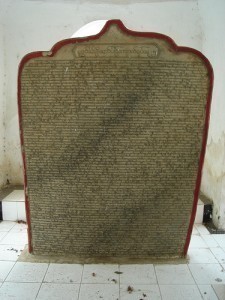What is the Largest Book?
Located in Mandalay, Myanmar, the world’s largest book is indeed so large that it took an entire temple, the Kuthodaw Pagoda, to contain it. It is also unlike any book that we have ever seen: composed of 730 leaves and 1,460 pages, each measuring 3 1/2 feet wide, 5 feet tall and 5 inches thick, and carved out of marble.
The book was constructed under the orders of King Mindon Min, who had ruled Burma (Myanmar) from February 18, 1853 to October 1, 1878. The king had wanted to leave behind for posterity a work of great merit intended to last for 5 millennia after Gautama Buddha (who had lived at about 500 BC). He was also concerned that the British invasion of southern Burma during the mid 19th century might have a detrimental effect on Buddhist dhamma (or teachings) in the North, where he ruled.
To preserve the Buddhist teachings in his kingship, King Mindon ordered the construction of the world’s largest book, which began on October 14, 1860. The book initially consisted of 729 massive marble tablets, upon which is inscribed in gold the Theravada Buddhism’s Tipitaka Pali canon. An additional marble tablet was made, a record of how everything came to be, to make a total of 730 tablets.
The book’s text had been edited meticulously from the Tipitaka (which means “3 baskets,” which consists of the Vinaya Pitaka, the Sutta Pitaka, and the Abhidhamma Pitaka), which had been kept in the royal libraries as palm leaf manuscripts, or peisa. The text was copied carefully by the scribes to be inscribed on marble by the stonemasons.
Each tablet contained 80 up to 100 lines of text inscribed on both sides in round Burmese script, carved out and then filled with gold ink. A scribe would take 3 days to copy each side, and a stonemason would be able to finish around 16 lines per day. The stone tablets were finally completed and made open to the public on May 4, 1868.
The world’s largest book was brought to the Kuthodaw Pagoda at Mandalay Hill, each tablet housed in a kyauksa gu (or “stone inscription cave” in Burmese), small cave-like structures topped by precious gems. However, when the North was later invaded by the British, the temples and pagodas in the area were desecrated and looted for gems and valuables.
After the withdrawal of British troops, following a petition to Queen Victoria, restoration of the temples began in 1892, but their former glory would not be recaptured. The gold inscription on the tablets had largely faded, now filled in with black ink made out of soot and ash, and only a few gems still remain. Nonetheless, Buddha’s teachings are still preserved on the world’s largest book, which remains an important shrine of Buddhist devotion, as well as a popular tourist destination.





